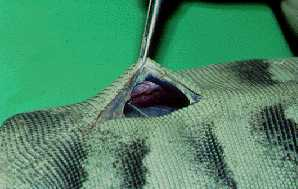Lizard and Snake Surgery
Jump to navigation
Jump to search
| This article is still under construction. |
Reptilian surgery has much in common with mammalian surgery with some special considerations.
Preparation
- Assess hydration, metabolic and nutritional status and correct as necessary. Ideally take a blood sample. Use aseptic technique.
- Administer preoperative antibiotics if intraoperative contamination is possible. Consider the ambient temperature within the POTZ.
- Position by ties or tapes. Perform a thorough skin preparation. Clear drapes are preferable to cotton drapes since it is still possible to see the patient under them.
Surgical instruments
Instruments are similar to those used in mammalian surgery:
- Magnification
- Radiosurgery
- Haemoclips
- Dental curettes and cerumen loops useful for abscesses
- Eyelid retractors useful as abdominal retractors
- Cotton buds and swabs
Coeliotomy approach
- Paralumbar and midline approaches are recommended.
- Serious haemorrhage can occur if the ventral abdominal vein (which is very large and located on the ventral midline a few millimetres deep to the linea alba) is cut. A paramedian incision is recommended to avoid this. If a ventral midline approach is used great caution is advised!
Wound healing
- Surgical incisions strengthen slowly because of the physiology of reptile would healing. Factors affecting wound healing include: ambient temperature, hygiene, orientation. Leave sutures in for at least three to six weeks.
- Absorption of buried sutures appears prolonged because reptiles may lack proteolytic enzymes. Do not use catgut.
- Skin incisions tend to invert so use an everting suture pattern. Do not use continuous suture pattern in areas of stress
Post-operative care
- Use a warm post-operative environment.
- Doxapram hydrochloride is an effective respiratory stimulant and can be used in apnoeic lizards (hypercapnia rather than hypoxaemia drives respiration in reptiles).
- Give fluids to maintain hydration.
- Once awake and responsive place in a warm, dark, quiet environment.
